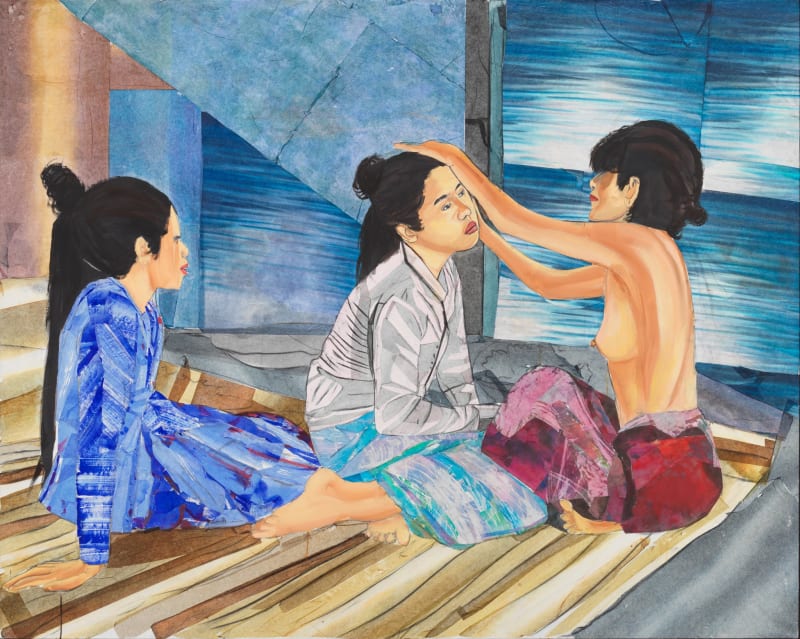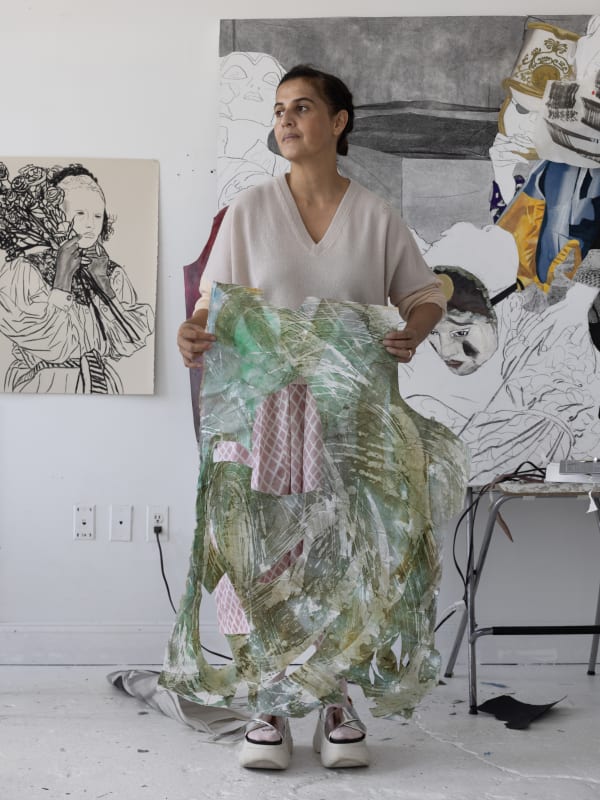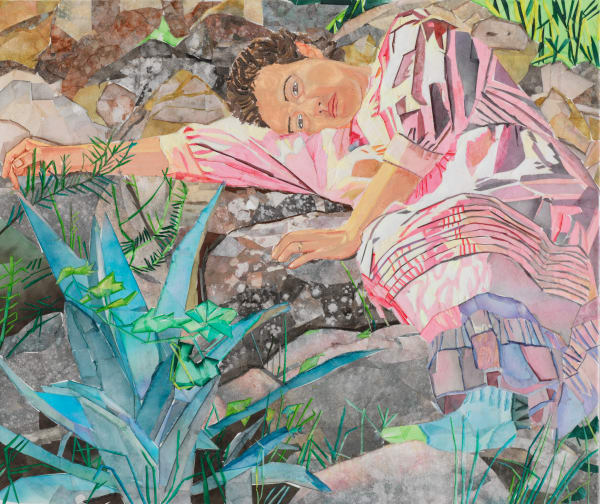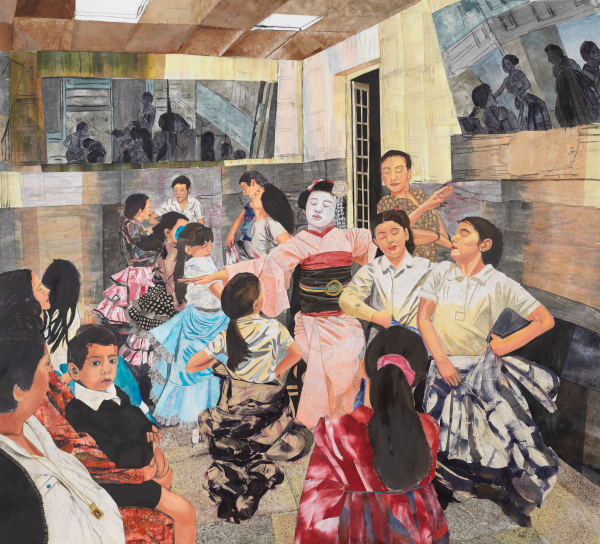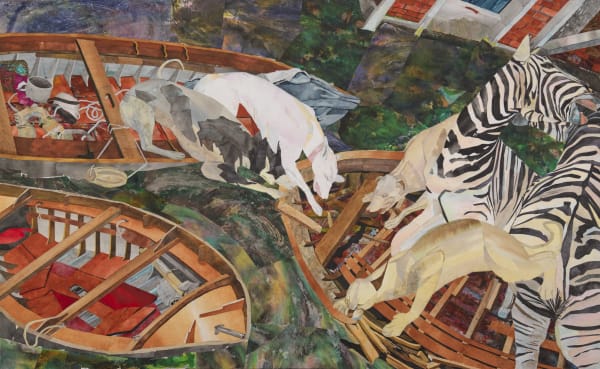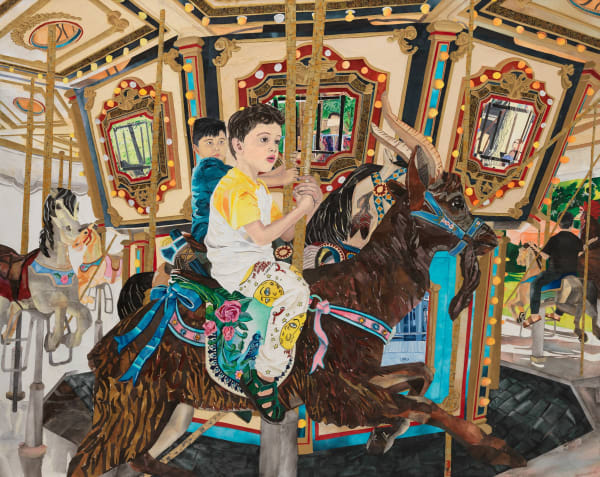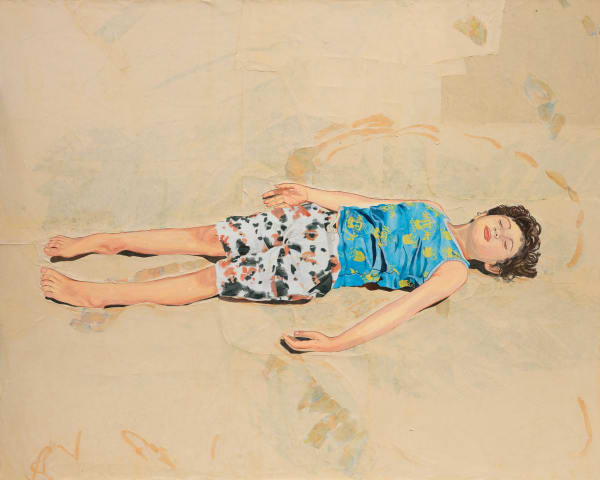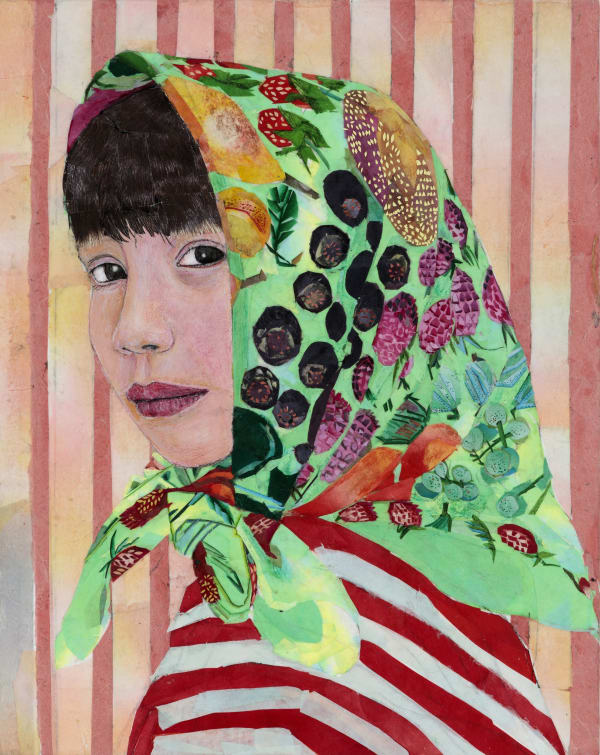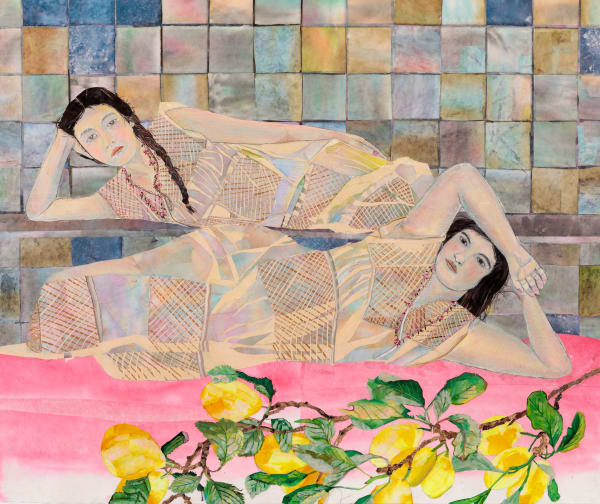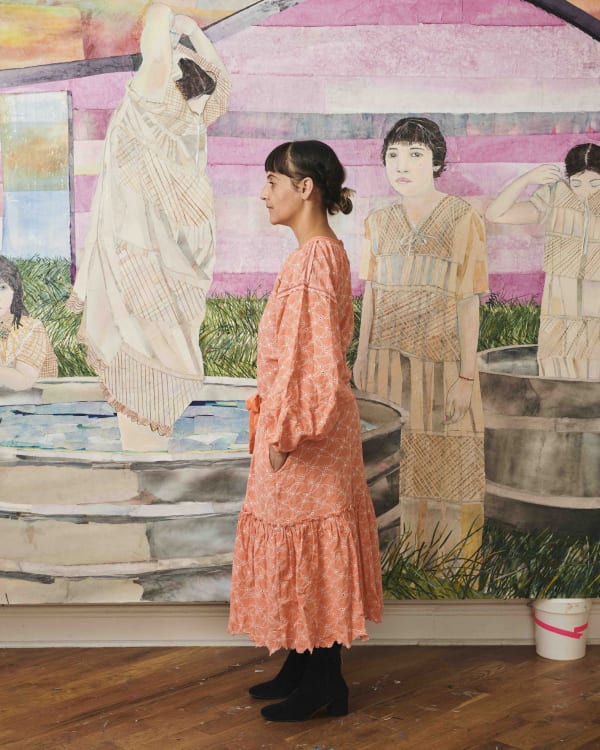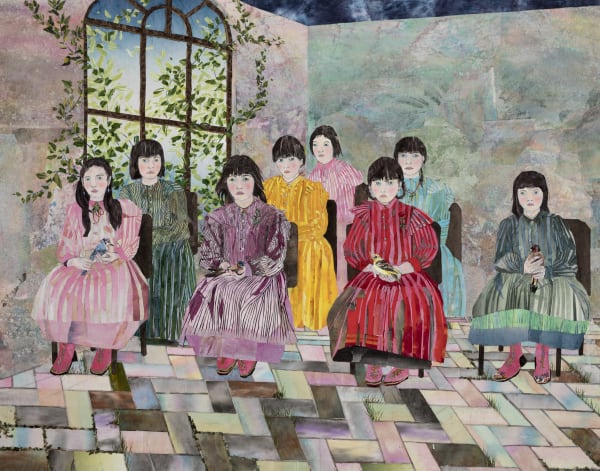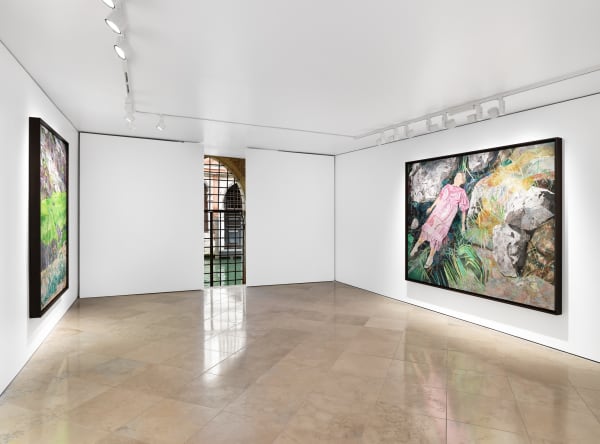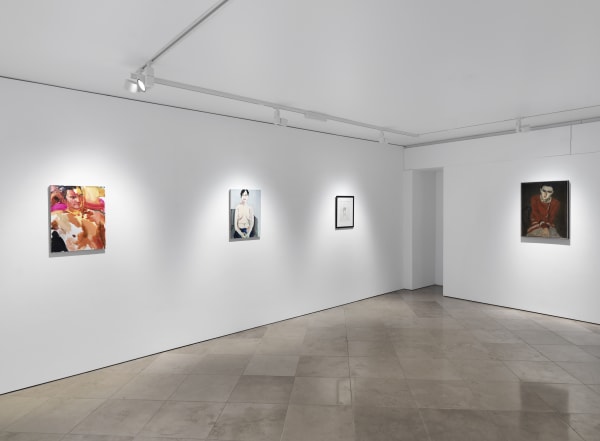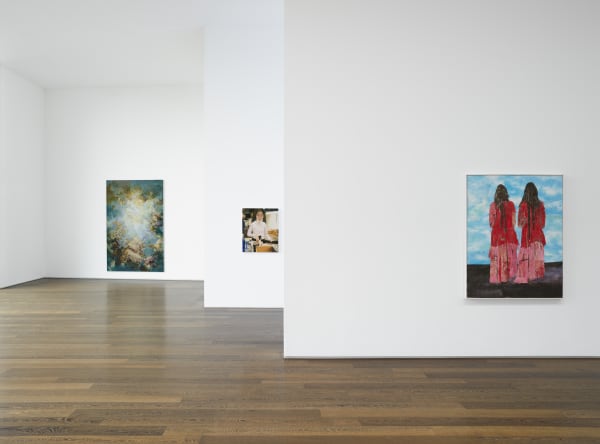María Berrío
-
About
María Berrío is celebrated for works that draw on aspects of mythology and folklore to create narratives that address contemporary issues of identity, agency and survival. Her large-scale works, which are meticulously crafted from watercolour paint and layers of Japanese paper, reflect on cross-cultural connections and global migration seen through the prism of her own history. Populated principally by women and children, Berrío’s art often appears to propose spaces of refuge or safety, kaleidoscopic utopias which have been inspired in part by South American folklore, where humans and nature coexist in harmony. To these apparently idealised scenes, however, Berrío brings to light the hard realities of present-day politics.
Archetypal themes of the search or quest, along with the rituals and symbolism of the mask, often envelop Berrío’s works. However, her imagery always comes first, with aspects of character and narrative tension built through composition and the choreography of space.
-
Biography
María Berrío was born in Bogotá, Colombia in 1982. She completed her BFA at Parsons School of Design in 2004, and her MFA at the New York School of Visual Arts.
Major solo exhibitions include María Berrío: The Children's Crusade, ICA Boston, USA (2023); María Berrío: Esperando mientras la noche florece (Waiting for the Night to Bloom), The Norton Museum of Art, West Palm Beach, Florida, USA (2021).
Institutional group exhibitions include Forbidden Territories: 100 Years of Surreal Landscapes, The Hepworth Wakefield, Wakefield, UK (2024–25); Shifting Landscapes, Whitney Museum of American Art, New York, USA (2024–26); Spirit in the Land, Nasher Museum of Art at Duke University, Durham, North Carolina, USA (2023), travelling to Pérez Art Museum, Miami, USA (2024) and Cummer Museum of Art & Gardens, Jacksonville, USA (2024–25); Women Painting Women, The Modern, Fort Worth, Texas, USA (2022); A Natural Turn, The DePaul Art Museum, Chicago, USA (2022); Born in Flames: Feminist Futures, Bronx Museum of the Arts, New York, USA (2021); Labor: Motherhood & Art in 2020, University Art Museum at New Mexico State University, Las Cruces, USA (2020); Present Tense: Recent Gifts of Contemporary Art, Philadelphia Museum of Art, Pennsylvania, USA (2019); People Get Ready at Nasher Museum of Art, Durham, North Carolina, USA (2018); Prospect.4 Triennial, New Orleans, USA (2017–18), Art on Paper Biennial, Weatherspoon Museum, Greensboro, North Carolina, USA (2017), CUT N MIX, El Museo del Barrio, New York, NY, USA (2015).
Berrío's work is in permanent collections including the Albertina, Wien, Austria; Brooklyn Museum, New York, USA; Crystal Bridges Museum of American Art, Bentonville, AR, USA; Dallas Museum of Art, USA; Ford Foundation Center for Social Justice, New York, USA; Hirshhorn Museum and Sculpture Garden, Washington DC, USA; Institute of Contemporary Art (ICA), Boston and Miami, USA; Los Angeles County Museum of Art (LACMA), USA; The Metropolitan Museum of Art, New York, USA; Museum of Contemporary Art Chicago, USA; Nasher Museum of Art at Duke University, Durham, USA; Pennsylvania Academy of the Fine Arts, Philadelphia, USA; Pérez Art Museum, Miami, Florida, USA; Philadelphia Museum of Art, Pennsylvania, USA; Speed Art Museum, Louisville, USA; Weatherspoon Museum of Art at the University of North Carolina, Greensboro, USA; Whitney Museum of American Art, New York, USA; Yuz Museum, Shanghai, China.
Additionally, her work can also be seen in the public realm at the N subway stop at Fort Hamilton, Brooklyn, where 14 of the artist's works have been translated in mosaic using a variety of media including glass, ceramic and enamel.
-
News
-

María Berrío: The End of Ritual reviewed in Frieze
December 10, 2024‘These works are metaphors for survival, piecing together fragments to make sense of a broken world.’ – Sofia HallströmRead More -

María Berrío talks to Artnet about her new exhibition, The End of Ritual
November 21, 2024‘It has felt like constructing a world over the last couple of years, as different characters have come into my work.’Read More -

María Berrío features in Forbidden Territories: 100 Years of Surreal Landscapes at The Hepworth Wakefield
November 19, 2024On view 23 November 2024–21 April 2025, the exhibition takes the viewer on a journey through the fantastical terrains of Surrealism over 100 years, looking...Read More -

The World of Interiors Previews María Berrío: The End of Ritual
November 16, 2024'These somewhat restless images are an attempt to grapple with a new world order, one that has largely done away with forms of human connection and ceremony on which we relied for so long.'Read More -

Spotlight: María Berrío at The FLAG Art Foundation
March 18, 2024The Spotlight series includes a new or never-before-exhibited artwork paired with a commissioned piece of writing, creating focused and thoughtful conversations between the visual arts...Read More -

María Berrío, Idris Khan, John Kørner and Tal R create new works for From the Ashes
February 21, 2024Organised by Migrate Art, this fundraising exhibition and auction supports the Xingu Indigenous communities of the Amazon Rainforest. All works have been created using ink,...Read More -

María Berrío is the honouree for this year’s TWO x TWO for AIDS and Art gala
October 23, 2023María Berrío received the amfAR Award of Excellence for Artistic Contributions to the Fight Against AIDS in recognition of her generous support of amfAR’s programmes....Read More -

Works by María Berrío, Doron Langberg and Alice Neel feature in Friends & Lovers at The FLAG Art Foundation
October 6, 2023This expansive group exhibition (6 October 2023–20 January 2024) centers on relationships between artists and their subjects and explores the infinite ways, both past and...Read More -

María Berrío features on the cover of Whitewall
September 21, 2023The artist María Berrío is showing no signs of slowing down. After her survey at the Norton Museum of Art just a few years ago,...Read More -

The Armory Show – María Berrío: A Feast for Ammit
September 6, 2023 Read More -

Now available to view on Vortic – María Berrío: The Children’s Crusade
August 9, 2023 Read More -

María Berrío: The Children’s Crusade is reviewed by The Boston Globe
February 26, 2023At the ICA, childhood lost in transition ‘The ambiguity is the point: Berrío’s works are powerfully alluring, both in craft and sentiment: They ache with...Read More -

María Berrío: The Children’s Crusade at ICA Boston
February 16, 2023New York–based artist María Berrío (born 1982 in Bogotá, Colombia) crafts her large-scale paintings through a unique, meticulous process of collaging torn pieces of Japanese...Read More -

María Berrío: The Land of the Sun is reviewed by Artforum
December 2, 2022‘In The Land of the Sun , Berrío made audible the silence that follows a catastrophe. Her powerful narrative works convey a solemn call for...Read More -

Women Painting Women opens at the Modern Art Museum of Fort Worth
May 15, 2022Bringing together portraits by 46 female artists who choose women as subject matter in their works, including María Berrío, Njideka Akunyili Crosby, Chantal Joffe, Alice...Read More -

María Berrío at Frieze New York: a new work in support of UNICEF
May 12, 2022María Berrío: The Cuttings Frieze New York, The Shed, Booth A5 18–22 May 2022 Victoria Miro presents a significant new painting by María Berrío at...Read More -

María Berrío: Children’s Crusade at Frieze Los Angeles
February 10, 2022VIP preview: 17 February 2022, 10am–7pm Public days: 18–20 February 2022 Children’s Crusade is a solo presentation of new works by María Berrío. Created especially...Read More -

María Berrío is announced as a 2021 Joan Mitchell Fellow
October 13, 2021The artist is an inaugural recipient of the new Joan Mitchell Fellowship, awarded by the Joan Mitchell Foundation. Speaking about her work, the artist says,...Read More -

Frieze reviews Born in Flames: Feminist Futures featuring María Berrío and Wangechi Mutu
July 15, 2021Visitors to ‘Born in Flames: Feminist Futures’ at The Bronx Museum of Arts will first encounter Wangechi Mutu’s Heelers (2016): stiletto-shaped clay sculptures – with...Read More -

María Berrío features in W Magazine’s major feature on contemporary figurative art, with text by Siddhartha Mitter
March 5, 2021Growing up in Colombia in the ’80s and ’90s, during the years of insurgency and drug wars, María Berrío turned to myths and legends to...Read More -

María Berrío: Esperando mientras la noche florece (Waiting for the Night to Bloom) at the Norton Museum of Art
January 2, 2021The first survey (2 January–9 May 2021) of María Berrío’s art includes two new pieces. Berrío’s large-scale, brilliantly coloured collages are meticulously crafted from unique...Read More -

Watch the video: María Berrío and Katy Hessel in conversation
October 28, 2020 Read More -

Artsy reports on María Berrío’s exhibition Flowered Songs and Broken Currents
October 14, 2020Charlotte Jansen writes about María Berrío's current exhibition on view at Victoria Miro until 27 November 2020. ‘The cyclical rhythms of nature provide the atmosphere...Read More -

ARTnews announces Victoria Miro’s representation of María Berrío
November 25, 2019María Berrío Joins Victoria Miro Victoria Miro , which has galleries in London and Venice, now represents María Berrío , whose work will figure in...Read More -

Victoria Miro announces representation of María Berrío
November 25, 2019Victoria Miro is pleased to announce representation of María Berrío . Work by the Brooklyn-based artist will feature as part of the gallery’s presentation at...Read More -

Waldemar Januszczak includes Victoria Miro’s summer group show in his Sunday Times Culture review
June 16, 2019 Read More -

María Berrío talks to Interview
June 5, 2019To glance at a María Berrío work is to immerse oneself in a multi-textural wonderland, a vivid colorscape where women reign eternal—with cacti around their...Read More -

María Berrío talks to The Georgia Review in a cover feature interview for the spring 2019 issue
February 15, 2019The creator of striking large-scale multimedia collages that “blur biographical memory with South American mythology,” María Berrio is a Colombian-born artist living and working in...Read More -

Ann Hackett contemplates the relationship between humankind and nature in María Berrío’s collages
March 13, 2018Living with the Land: Maria Berrio in Prospect.4: The Lotus in Spite of the Swamp Girls replace their arms with feathered wings. A women cradles...Read More
-
-
Books
-

María Berrío – special edition with print
Siddhartha Mitter/María Berrío, 2024Hardcover, 150 pagesLearn More
Publisher: Victoria Miro
Dimensions: 31.6 x 23.8 cm -
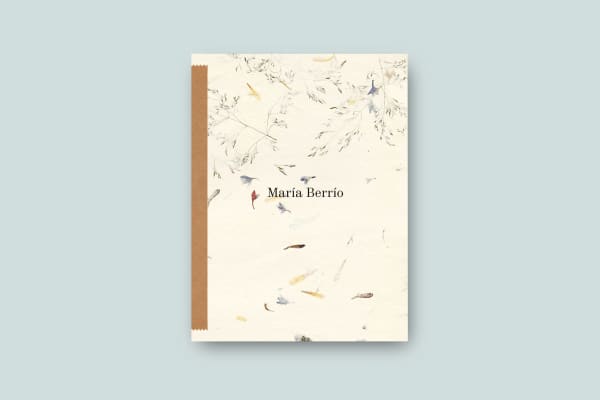
María Berrío
Siddhartha Mitter/María Berrío, 2024Hardcover, 150 pagesLearn More
Publisher: Victoria Miro
ISBN: 978-1-914506-15-4
Dimensions: 31.6 x 23.8 cm
-
-
Gallery Exhibitions
-

María Berrío: The End of Ritual
21 Nov 2024 – 18 Jan 2025 London Gallery IThe End of Ritual depicts moments of disquiet articulated within densely populated interiors, spaces where the old world meets the new and a restless dynamic unfolds between performers and spectators...Learn More -

Motion in Stillness: Dance and the Human Body in Movement
21 Nov 2024 – 18 Jan 2025 London Gallery IIPresented by Vortic and Victoria Miro, Motion in Stillness: Dance and the Human Body in Movement presents works by artists who all have a relationship with dance or with the human body in movement.Learn More -

María Berrío: The Land of the Sun
17 Sep – 29 Oct 2022 VeniceIn this new body of work, Berrío conjures an apocalyptic scenario, against which the efforts of her central character become Sisyphean as she journeys through a world of heat and dust.Learn More -

Unmasked
12 Feb – 27 Mar 2022 VeniceAn exhibition in Venice of works by Milton Avery, Jules de Balincourt, Hernan Bas, María Berrío, Chantal Joffe, Doron Langberg, Alice Neel and Celia Paul.Learn More -

María Berrío: Flowered Songs and Broken Currents
6 Oct – 18 Dec 2020 London Gallery IIIn these works, the artist explores how the formation of historical memory occurs amidst processes of grieving in a village that maps the site of her own imagination.Learn More -

María Berrío, Caroline Walker, Flora Yukhnovich
7 Jun – 27 Jul 2019 London Gallery IIA summer exhibition featuring three young artists who rethink traditional genres to touch upon themes of migration, the workplace, and the gendered language of painting.Learn More
-
-
Contact Form
Contact us regarding available works by María Berrío
